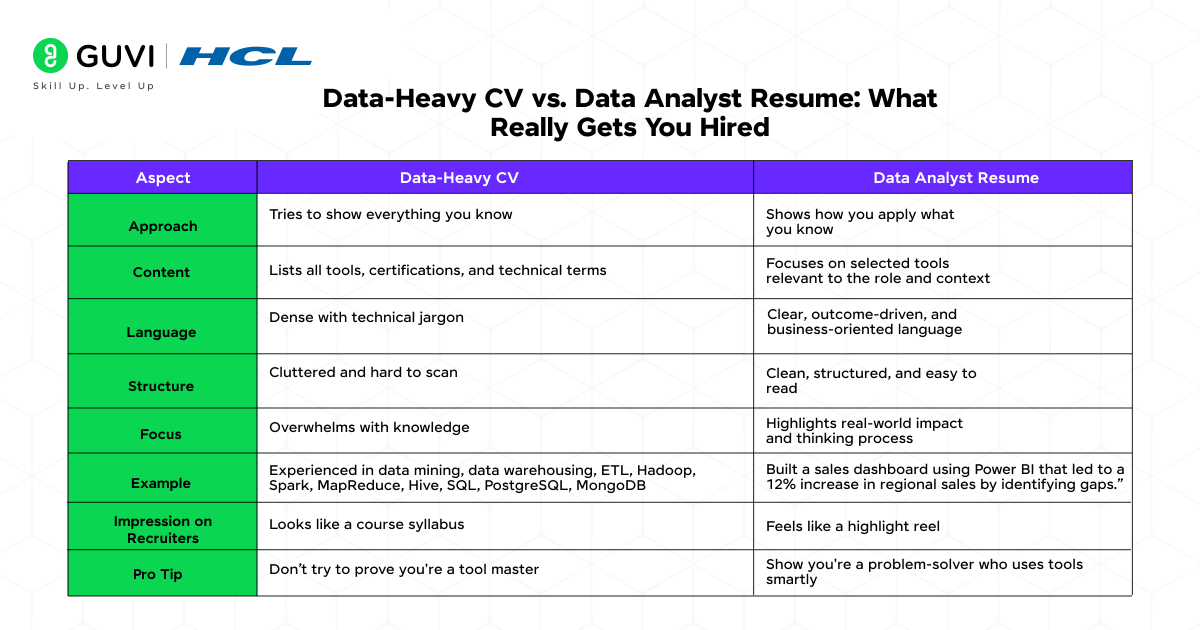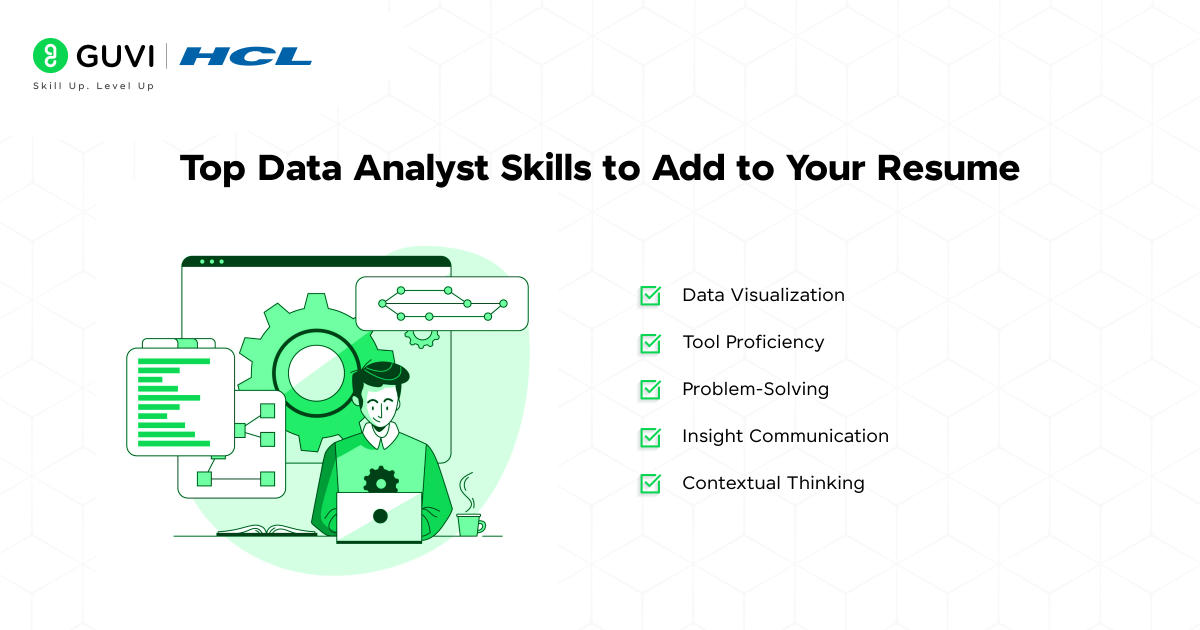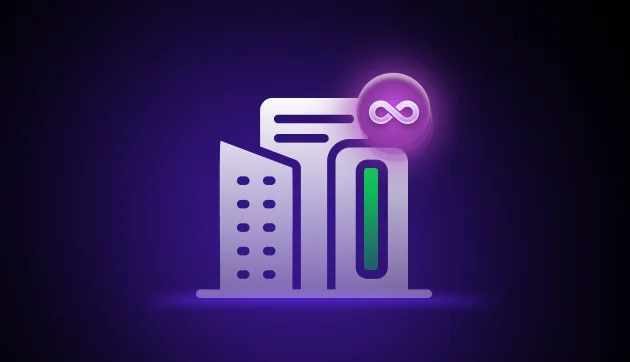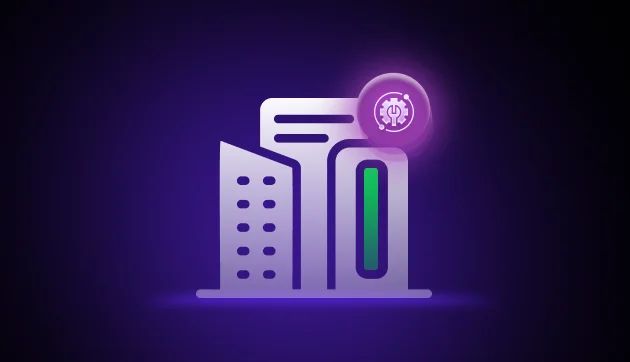
Crafting the right resume is crucial, and that’s where smart data analyst resume tips come in.
Data analytics is a highly competitive field. According to Analytics Insight, by 2025, the number of data science job openings in India is expected to reach approximately 1,37,630, which is more than double the 62,793 recorded in 2020.
What do these statistics tell us? As much as the growth opportunities are massive in this field, the competition is just as intense. Your technical skills will help you thrive in your role, but to land that role in the first place, your resume has to make a solid first impression.
Your resume should speak for you before you even enter the interview room. It should reflect your ability to think clearly, work with data confidently, and drive decisions with insights. It’s not just about listing tools and degrees. It’s about showing impact, communicating clearly, and presenting your profile in a way that stands out in a recruiter’s inbox.
In this blog, you’ll learn the data analyst resume tips that don’t just check boxes but get you shortlisted. From structure and layout to showcasing your technical skills and real-world impact, we’ll break down everything you need to know to craft a job-winning resume.
Table of contents
- Common Mistakes Beginners Make
- What Makes a Data Analyst Resume Different?
- The Difference Between a Data-Heavy CV and a Data Analyst Resume
- What Recruiters Look for in a Data Analyst Resume | Data Analyst Resume Tips
- Types of Data Analyst Roles and Resume Customization
- How to Tailor Your Resume for Each Role
- Final Thoughts
- FAQs
- What to put on a resume for a data analyst?
- What are the key skills for a data analyst?
- How do you write a resume for a fresher data analyst?
- How do you write a data analyst objective on a resume?
- How do I write a good data analyst resume?
Common Mistakes Beginners Make
Before we dive into the details of creating a great resume, let’s first dissect the reasons why many data analyst resumes fall flat.
The average human attention span has dropped to 8.25 seconds, shorter than that of a goldfish.
Wondering what that has to do with your resume and your job search? In a world of overflowing applications and limited recruiter time, your resume has only a few seconds to make an impact. If it doesn’t grab attention instantly, it’s ignored. Simple as that.
Here are 5 common mistakes beginners make when crafting their data analyst resumes:
- Using too much jargon instead of showcasing real skills
Buzzwords and complex terminology don’t impress if they don’t convey your capabilities. Keep it crisp and meaningful. - Not highlighting project work or practical experience
Recruiters want to see how you’ve applied your skills, real data sets, tools used, and problems solved. Projects speak louder than theory. - Making it too generic
A one-size-fits-all resume won’t cut it. Tailoring your resume to each role with relevant keywords and job-specific accomplishments is key. - Neglecting metrics and impact
Saying you “analyzed data” isn’t enough. Did your analysis reduce costs by 20%? Improve efficiency? Numbers make your work tangible. - Cluttered or outdated formatting
A confusing layout or old-school design can make even a good profile look sloppy. Clean, modern formatting helps your content shine.
What Makes a Data Analyst Resume Different?
You’re already 50% sorted once you know what not to do with your resume. Now, let’s crack the other half: how do you stand out in a sea of applicants?
Here’s the golden rule: A great resume isn’t just a list of skills. It’s a snapshot of your value. And that value should be clear within seconds.
Let’s break it down.
1. Never miss out on the basics
This sounds obvious, but it’s surprising how many people skip key contact details like their phone number, a professional email address, or even links to their GitHub and LinkedIn profiles. These might feel secondary, but they’re your recruiter’s first gateway to reach you.
2. A strong profile summary
Think of this like a movie trailer. It sits right at the top of your resume and should instantly communicate who you are, what you’re skilled at, and what you’re looking for.
Avoid generic lines like:
“I am a hardworking, motivated individual looking for opportunities.”
Here’s a better version:
“Data Analyst skilled in SQL, Python, and Power BI, with hands-on experience analyzing customer behavior trends and optimizing dashboards for a retail e-commerce client. Seeking a challenging role to apply data-driven decision-making at scale.”
What was missing in the earlier one?
– No mention of technical skills
– No hint of real-world experience or tools used
– No clarity on career direction
– Too vague to stand out
3. Projects and Internships
If you’re a beginner, this is where the spotlight needs to fall.
Projects are your proof of work. They show how you apply theory to real-world problems. Instead of listing 10 mini-projects, choose 2–3 solid ones and give them structure.
Here’s a good format:
Analyzed sales data from a chain of retail stores to identify underperforming locations. Used Python and Pandas for data cleaning, and Power BI for visualization. Resulted in a 15% increase in revenue after management implemented recommendations.
This tells the recruiter what you did, how you did it, and what impact it made.
4. Technical and Soft Skills
Group your skills clearly into categories.
For example:
- Technical: SQL, Python, Excel, Power BI, Tableau, Pandas
- Soft: Problem-solving, Communication, Critical thinking
Be selective and intentional. Instead of listing every tool you’ve heard of, include only those you’ve actively used in projects or hands-on practice.
5. Experience (if any)
If you’ve previously worked in a data-related role, this section needs to be sharp and results-driven.
One common mistake? Dumping job responsibilities like:
“Worked on reports, handled data, made presentations.”
This tells nothing about your actual impact. What recruiters want to see:
- The results you’ve delivered
- The insights you helped uncover
- The business decisions you influenced
- The tools or methods you used to get there
Here’s a better way to frame it:
Cleaned and structured customer data using SQL and Excel, reducing reporting time by 30%. Designed a dashboard that helped the sales team identify their top-performing customer segments, leading to a 10% increase in conversions.
But what if you don’t have any work experience yet?
No problem. This is exactly where your projects come into play. Treat your best 2–3 projects like mini-experience entries. Present them with the same clarity and structure, including the tools used and the outcome delivered. If possible, link to GitHub or dashboards that showcase your work.
The Difference Between a Data-Heavy CV and a Data Analyst Resume

Let’s clear this up. Just because you’re applying for a data analyst role doesn’t mean your resume has to be overloaded with data.
Here’s what most beginners get wrong: They confuse dumping data with demonstrating skill.
A data-heavy CV:
- Lists every tool, certification, and statistic you know
- Includes dense technical jargon
- Feels cluttered and hard to scan
- Tries to prove how much you know instead of how well you can apply it
Example:
“Experienced in data mining, data warehousing, ETL, Hadoop, Spark, MapReduce, Hive, SQL, PostgreSQL, MongoDB, Tableau, Power BI, Excel, R, Python, NumPy, Pandas, Matplotlib…”
That’s not impressive. It’s overwhelming.
A data analyst resume:
- Is selective, not stuffed
- Focuses on outcomes and context – what you did, how you did it, and what impact it had
- Highlights projects and business insights, not just tools
- Helps recruiters understand your thinking process, not just your tech stack
Example:
“Built a sales performance dashboard using Power BI for a retail client, leading to a 12% increase in regional sales by identifying underperforming SKUs.”
That’s what gets you noticed.
Pro Tip:
Don’t make your resume look like a course syllabus. Make it a highlight reel. You’re not hired for what you know, but for how you apply what you know to solve real problems.
What Recruiters Look for in a Data Analyst Resume | Data Analyst Resume Tips

The hiring process today is more automated than ever. Most companies use an Applicant Tracking System (ATS) to scan resumes before a human even sees them. That means your resume isn’t just competing with people — it’s competing with software.
So, how do you stand out?
It’s simple: tailor your resume to the job description. Don’t fake experience; instead, align your language and skills with what the job asks for.
To make things easier, here’s a curated list of must-have skills that recruiters expect on a strong data analyst resume.
Technical Skills (Hard Skills Recruiters Want)
Data Analysis & Tools
- Excel: Pivot tables, VLOOKUP
- SQL: Queries, joins, subqueries
- Python or R: Data manipulation and analysis
- Statistical concepts: Distributions, confidence intervals, probability
Data Visualization
- Tools: Power BI, Tableau, Looker
- Focus: Presenting insights clearly for business teams
Data Handling & ETL
- Data cleaning and wrangling
- Data modeling and structuring
- Familiarity with ETL processes
Programming & Scripting
- Python: pandas, numpy, matplotlib, seaborn, scikit-learn
- R: tidyverse, ggplot2
- Jupyter Notebook or RStudio
Version Control & Platforms
- Git and GitHub
- Google Sheets
- Cloud tools: AWS, Google BigQuery (role-dependent)
Machine Learning Basics (for advanced roles)
- Regression, classification, clustering
- Model evaluation metrics (accuracy, precision, recall, etc.)
Soft Skills (Thinking and People Skills)
Problem-Solving
- Ability to tackle messy, real-world data problems
- Root-cause analysis and structured thinking
Communication
- Explaining insights in simple, non-technical language
- Turning data into actionable stories and presentations
Critical Thinking
- Asking the right questions
- Exploring not just what happened, but why
Business Acumen
- Understanding KPIs and business objectives
- Aligning analysis with company goals
Collaboration & Time Management
- Working with product, marketing, or engineering teams
- Managing multiple tasks, meeting deadlines, and adapting to feedback
Pro Tip: While polishing your resume is a great first step, having solid projects and certifications to back it up is what sets you apart. If you’re looking to add that extra edge, HCL GUVI’s Free Resources page is a goldmine. You’ll find real-world datasets, mini-projects, and curated content that not only help you learn but also give you portfolio-ready additions for your resume.
Types of Data Analyst Roles and Resume Customization
Not all data analyst jobs are the same, and neither should your resume be.
Depending on the role, companies look for very specific skills, tools, and domain knowledge. Here are a few common types of data analyst roles:
- Business Intelligence (BI) Analyst: Focuses on dashboards, KPIs, reporting tools like Power BI/Tableau, and often supports internal decision-making.
- Marketing Analyst: Works closely with campaign data, customer segmentation, A/B testing, and tools like Google Analytics or Mixpanel.
- Product Analyst: Collaborates with product teams to analyze user behavior, feature usage, and retention using tools like Amplitude or SQL.
- Financial/Data Analyst: Deals with forecasting, budgeting, and financial modeling, using tools like Excel, SQL, and sometimes Python or R.
- Operations/Data Analyst: Focuses on process efficiency, logistics, and backend systems using Excel, SQL, and data visualization tools.
How to Tailor Your Resume for Each Role
One resume does not fit all. Customization is key:
- Study the job description carefully and mirror the keywords and skills they mention. Many companies use Applicant Tracking Systems (ATS) that filter resumes based on keyword matches.
- Highlight domain-relevant experience. For instance, if applying for a Marketing Analyst role, emphasize projects involving user acquisition or campaign metrics.
- Swap out tools and terminology. A BI Analyst resume should feature dashboards, KPIs, and tools like Power BI, while a Product Analyst resume should talk about funnels, user cohorts, and tools like Amplitude or Mixpanel.
Bonus Tip: Keep a master resume with all your experiences. From this, create tailored versions depending on the role you’re applying for.
If you’re serious about landing a role as a Data Analyst, your resume needs projects, tools, and job-ready skills that prove your capabilities. That’s exactly what HCL GUVI’s Zen Class Data Science Course is designed to deliver.
This industry-aligned program helps you go beyond theory. You’ll master tools like Python, SQL, Power BI, and Excel while working on real-world projects in data visualization, predictive modeling, and more — the kind of experience that makes hiring managers take notice.
By the time you complete the course, you won’t just have the skills — you’ll have a resume that proves them.
Check out HCL GUVI’s Zen Class Data Science Course today and start building a profile that gets shortlisted.
Final Thoughts
Before you start actively hitting “Apply” on job portals, here’s what you need to keep in mind:
A poorly structured or outdated resume can cost you great opportunities, even if you have the skills. Your resume isn’t just a document; it’s your first impression. Make it count.
Update it regularly to reflect your latest achievements, tools you’ve mastered, and real-world projects you’ve completed. And most importantly, don’t wait till the end of your learning journey to start building it. Craft your resume alongside your upskilling efforts, so you’re always ready when the right opportunity comes your way.
With the right skills, a solid resume, and the confidence to back it up, you won’t just apply for jobs; you’ll get noticed.
FAQs
1. What to put on a resume for a data analyst?
Include your technical skills (like SQL, Excel, Python), projects, certifications, education, relevant experience, and a concise summary highlighting your ability to extract insights and solve business problems.
2. What are the key skills for a data analyst?
Key skills include data cleaning, SQL, Excel, Python or R, data visualization, critical thinking, business acumen, communication, problem-solving, and experience with tools like Tableau or Power BI.
3. How do you write a resume for a fresher data analyst?
Focus on academic projects, online certifications, internships, and technical skills. Use a strong objective, show tools you’ve worked with, and emphasize problem-solving and analytical thinking in your projects.
4. How do you write a data analyst objective on a resume?
Write a short, focused statement showing your career goals, relevant skills, and eagerness to contribute using data analysis. Tailor it to the role and highlight what you can offer.
5. How do I write a good data analyst resume?
Use a clean format, highlight in-demand skills, quantify achievements, showcase projects, and tailor your resume to each job description. Keep it clear, concise, and free of jargon or fluff.




































Did you enjoy this article?